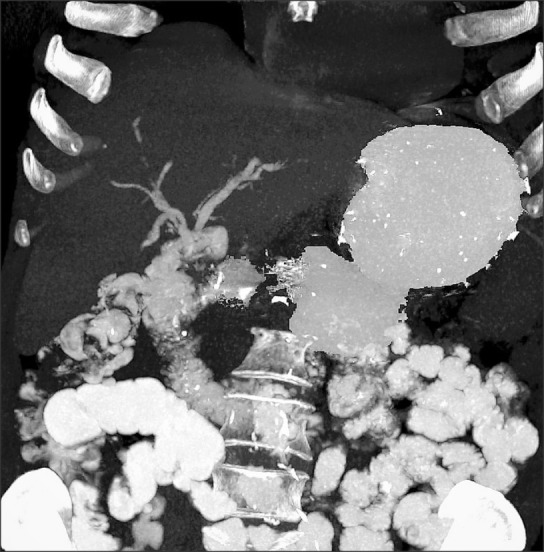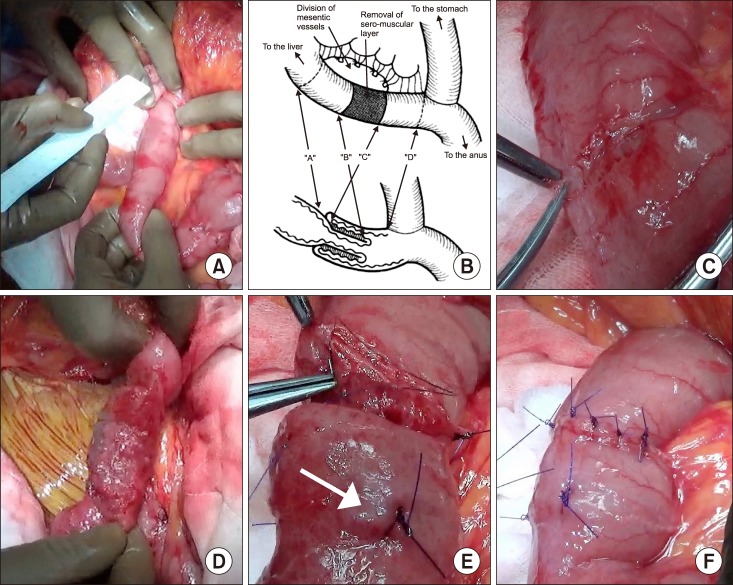Ann Hepatobiliary Pancreat Surg.
2018 Feb;22(1):90-92. 10.14701/ahbps.2018.22.1.90.
Restoring one way traffic across the Roux loop: The Nakajo value
- Affiliations
-
- 1The Institute of Liver Disease & Transplantation, Global Hospitals & Health City, Chennai, India. ashwinrammohan@gmail.com
- 2Department of Hepatobiliary Pancreatic Surgery & Transplantation, Ministry of Health, Muscat, Oman.
- 3Institute of Liver Studies, King's College Hospital, London, UK.
- KMID: 2409086
- DOI: http://doi.org/10.14701/ahbps.2018.22.1.90
Abstract
- Roux-en-Y (RY) hepaticojejunostomy (HJ) is a critical component of complex hepatobiliary operations, and it is the treatment of choice for post-cholecystectomy biliary strictures (PCBS). Complications related to the Roux limb, particularly those leading to cholangitis, can severely compromise outcomes. We present a case of a 54-year-old lady who had previously undergone two HJ procedures for recurrent PCBS. The same Roux limb had been used in each of the operations. Short Roux/Roux reflux syndrome led to recurrent cholangitis in this patient, as proven by the reflux of oral contrast into the biliary tree on imaging. This was effectively treated by lengthening the Roux limb (60 cm) with a redo-jejunojejunostomy, and creation of a Nakajo type valve. One-year post surgery, the patient remains well at follow-up. Enteric reflux into the biliary tree may lead to refractory cholangitis. We present the first ever case in an adult, where a simple and effective modification to the HJ obviated this complication.
MeSH Terms
Figure
Reference
-
1. Felder SI, Menon VG, Nissen NN, Margulies DR, Lo S, Colquhoun SD. Hepaticojejunostomy using short-limb Roux-en-Y reconstruction. JAMA Surg. 2013; 148:253–257. discussion 257-258. PMID: 23553273.
Article2. Nakajo T, Hashizume K, Saeki M, Tsuchida Y. Intussusceptiontype antireflux valve in the Roux-en-Y loop to prevent ascending cholangitis after hepatic portojejunostomy. J Pediatr Surg. 1990; 25:311–314. PMID: 2313499.
Article3. Honna T, Tsuchida Y, Kawarasaki H, Utsuki T, Mizuta K. Further experience with the antireflux valve to prevent ascending cholangitis in biliary atresia. J Pediatr Surg. 1997; 32:1450–1452. PMID: 9349766.
Article
- Full Text Links
- Actions
-
Cited
- CITED
-
- Close
- Share
- Similar articles
-
- Uncut Roux Procedure after Total Gastrectomy
- Percutaneous Cholangioscopic Lithotripsy for Afferent Loop Syndrome Caused by Enterolith Development after Roux-en-Y Hepaticojejunostomy: A Case Report
- Experience of stapled Unbalanced Uncut Roux-Y Gastrojejunostomy
- Obstructive Jaundice after Bilioenteric Anastomosis: Transhepatic and Direct Percutaneous Enteral Stent Insertion for Afferent Loop Occlusion
- Percutaneous transhepatic afferent loop balloon dilatation and indwelling catheter placement for benign afferent loop obstruction



